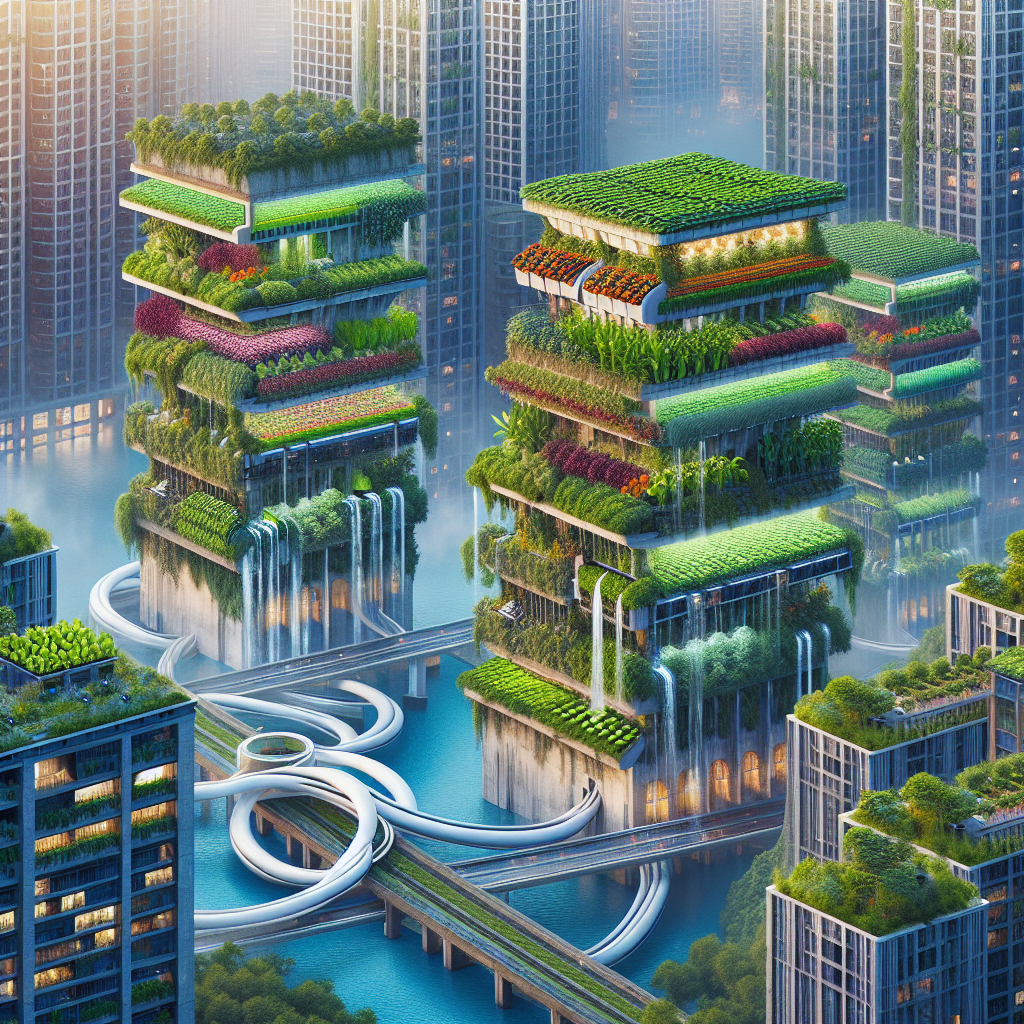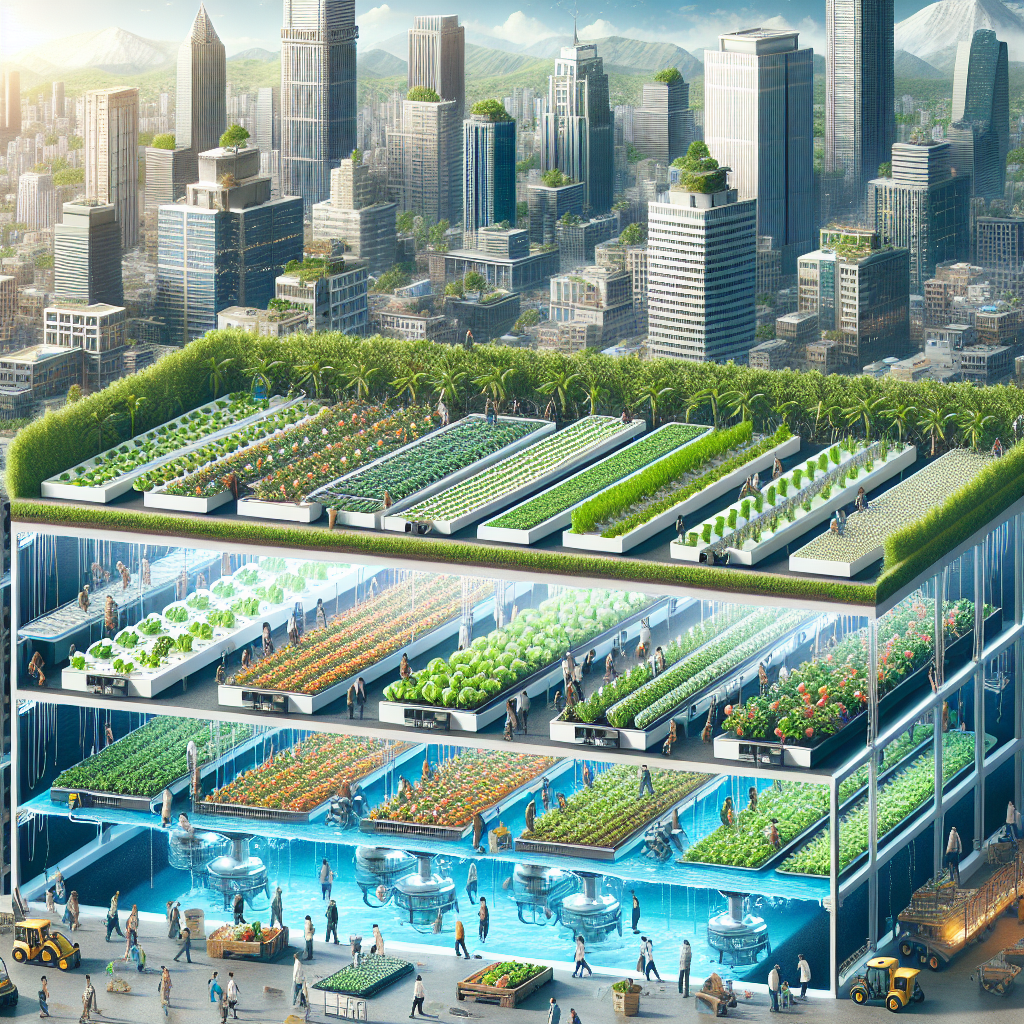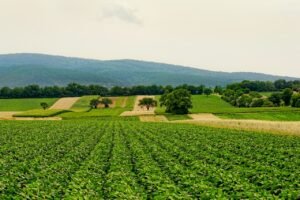
Are you interested in urban farming but concerned about the limited availability of water? Look no further! In this article, we explore sustainable solutions for water-constrained urban farming. Discover innovative methods and practical tips on how to successfully manage farming in areas where water is scarce. Whether you’re a seasoned urban farmer or just starting out, these solutions will help you overcome the challenges and cultivate a thriving farm while conserving precious water resources. Get ready to learn, adapt, and make a positive impact on your community with sustainable urban farming!
1. Efficient Irrigation Techniques
1.1 Drip Irrigation
Drip irrigation is a highly efficient technique that delivers water directly to the roots of plants, minimizing water loss through evaporation and runoff. With drip irrigation, water is delivered gradually and precisely to the plant’s root zone through a network of tubes or pipes with small holes or emitters. This method not only conserves water but also reduces the risk of diseases caused by excessive moisture on the plant’s leaves.
1.2 Micro-sprinkler Systems
Micro-sprinkler systems are another efficient irrigation technique that delivers water through small sprinkler heads directly to the plants’ base. These systems are designed to release water in a fine mist or spray, ensuring uniform coverage and minimal wastage. Micro-sprinklers provide flexibility in adjusting the water flow and distribution pattern, making them suitable for a variety of crops and soil types.
1.3 Aeroponics
Aeroponics is an innovative irrigation technique that uses a misting system to deliver water and nutrients directly to the roots of plants. In this method, plants are grown without soil, suspended in air or in a misting chamber. The plant roots are continuously misted with a nutrient-rich solution, allowing for maximum absorption and minimal water loss. Aeroponics not only conserves water but also promotes faster plant growth and higher yields compared to traditional growing methods.
1.4 Hydroponics
Hydroponics is a soilless farming technique that utilizes a nutrient-rich water solution to grow plants. With hydroponics, plants are grown in a controlled environment where their roots are submerged or constantly exposed to the nutrient solution. This method uses significantly less water compared to conventional farming methods since the water is recirculated and reused. Hydroponics also allows for precise control of nutrients, pH levels, and water availability, resulting in optimal plant growth and resource efficiency.
2. Rainwater Harvesting
2.1 Rooftop Collection
Rooftop collection is a simple and effective way to harvest rainwater for urban farming. By installing gutters and downspouts, rainwater can be directed into storage tanks or containers for later use. It is essential to use clean and impervious materials for the collection system to prevent contamination and ensure the quality of the harvested rainwater. Rooftop collection is particularly useful in areas with limited access to water sources, as it allows farmers to utilize the free and abundant resource of rainwater.
2.2 Rain Barrels
Rain barrels are a popular and cost-effective method for rainwater harvesting. These large containers, typically placed underneath downspouts, collect and store rainwater that can be used for watering plants. Rain barrels are easy to install and are equipped with a spigot for convenient access to collected water. They can also be connected to one another to increase storage capacity. By using rain barrels, farmers can reduce their reliance on municipal water supplies and conserve valuable resources.
2.3 Rain Gardens
Rain gardens are designed to capture and store rainwater in specially constructed garden beds. These gardens utilize native plants and strategically placed depressions or swales to collect and retain rainwater runoff. The plants in a rain garden help absorb excess water, filter pollutants, and recharge groundwater. By incorporating rain gardens into urban farming practices, farmers can not only conserve water but also create attractive and ecologically beneficial green spaces.
2.4 Permeable Surfaces
Permeable surfaces, such as porous asphalt or gravel, allow rainwater to infiltrate the soil instead of running off into storm drains. By using permeable surfaces in and around urban farming areas, rainwater can be effectively absorbed by the soil and replenish groundwater. This technique helps prevent water runoff, erosion, and flooding while promoting the natural recharge of water resources. Permeable surfaces are particularly useful in urban environments where open spaces are limited but efficient water management is crucial.

3. Greywater Recycling
3.1 Treatment and Filtration
Greywater recycling involves the collection and treatment of water from household activities like washing machines, sinks, and showers for reuse in irrigation. Before greywater can be utilized for watering plants, it undergoes a treatment and filtration process to remove impurities and contaminants. This can be achieved through various methods such as settling tanks, filtration systems, and disinfection processes. By recycling greywater, farmers can reduce their reliance on freshwater sources and contribute to water conservation efforts.
3.2 Greywater Reuse Systems
Greywater reuse systems are designed to collect and store treated greywater for later use in irrigation. These systems consist of storage tanks, filtration systems, and distribution networks that deliver recycled water to the plants’ root zones. Greywater reuse systems can be customized based on the specific needs and scale of urban farming operations, allowing farmers to optimize water efficiency and reduce their ecological footprint.
3.3 Greywater Irrigation
Greywater irrigation involves the direct application of treated greywater to plants, providing them with a source of water and essential nutrients. This method not only conserves freshwater but also reduces the discharge of greywater into the sewage system or the environment. It is important to note that proper filtration and disinfection of greywater are essential to ensure the health and safety of both plants and farmers. Greywater irrigation is a sustainable solution for water-constrained urban farming, promoting resource efficiency and responsible water management.
4. Aquaponics
4.1 Integration of Aquaculture and Hydroponics
Aquaponics is a unique farming system that combines aquaculture (fish farming) with hydroponics. In this integrated system, fish waste provides a nutrient-rich water source for plants, while the plants act as natural filters, purifying the water for the fish. By establishing a symbiotic relationship between fish and plants, aquaponics maximizes resource efficiency and minimizes water consumption. This closed-loop system allows for the sustainable production of both food and fish, making it an ideal option for water-constrained urban farming.
4.2 Nutrient Cycling
In aquaponics, nutrient cycling plays a crucial role in maintaining the balance between fish, plants, and water quality. The fish waste, primarily in the form of ammonia, is converted by beneficial bacteria into nitrates, which serve as the primary source of nutrients for the plants. As the plants absorb these nutrients, they help purify the water, creating a healthy environment for the fish. This continuous cycle of nutrient exchange minimizes waste and optimizes resource utilization in aquaponics farming.
4.3 Water Conservation
Aquaponics is inherently water-conserving as it recirculates and reuses water within the system. Unlike traditional farming methods where water is lost through evaporation or runoff, aquaponics maintains a closed-loop system that conserves water. The water requirements in aquaponics are significantly lower compared to conventional soil-based farming, making it an environmentally friendly and sustainable solution for urban farming in water-constrained areas.

5. Vertical Farming
5.1 Utilization of Limited Space
Vertical farming is a space-efficient technique that utilizes vertical structures to grow crops in stacked layers. By maximizing vertical space, urban farmers can overcome the limitations of limited land availability. Vertical farming systems can be implemented in various forms, such as vertical towers, shelves, or walls, depending on the specific requirements and constraints of the farming environment. This technique not only provides higher crop yields per unit area but also minimizes water usage by optimizing irrigation practices.
5.2 Hydroponics in Vertical Systems
Hydroponics is widely used in vertical farming systems due to its efficient water and nutrient delivery mechanisms. By employing hydroponic techniques, plants in vertical farming systems receive water and nutrients directly, reducing wastage and promoting optimal growth. Additionally, hydroponics allows for the precise control of pH levels, nutrient concentrations, and water availability, ensuring that plants receive the optimal conditions for growth. This combination of vertical farming and hydroponics offers a sustainable and resource-efficient solution for urban agriculture.
5.3 Energy Efficiency
Vertical farming systems often incorporate energy-efficient technologies such as LED lights and climate control systems to optimize plant growth and resource utilization. LED lights provide specific wavelengths of light that are optimal for photosynthesis, enabling plants to thrive in an indoor environment without relying solely on natural sunlight. Furthermore, climate control systems regulate temperature, humidity, and air circulation to create an optimal growth environment for crops. By utilizing energy-efficient technologies, vertical farming minimizes energy consumption and reduces its environmental impact.
6. Smart Irrigation Systems
6.1 Sensor-based Technology
Smart irrigation systems utilize advanced sensor technology to monitor soil moisture levels, weather conditions, and plant water requirements. These sensors provide real-time data, allowing farmers to adjust irrigation schedules and water application rates accordingly. By accurately assessing the actual water needs of plants, smart irrigation systems prevent overwatering and ensure efficient water usage. Sensor-based technology optimizes irrigation practices, conserves water, and promotes the health and growth of crops.
6.2 Real-time Data Monitoring
Real-time data monitoring is a key component of smart irrigation systems. By continuously monitoring soil moisture levels, rainfall patterns, and evapotranspiration rates, farmers can make informed decisions about when and how much to irrigate. This data-driven approach eliminates guesswork and allows for precise irrigation scheduling, tailoring water application to the specific needs of the plants. Real-time data monitoring maximizes water efficiency and minimizes waste, making it an essential tool for water-constrained urban farming.
6.3 Automated Irrigation
Automated irrigation systems reduce the reliance on manual intervention by automating the watering process based on pre-programmed schedules or sensor inputs. These systems can be set to deliver water at specific times, durations, and frequencies, ensuring consistent and efficient irrigation. Automated irrigation not only saves time and labor but also minimizes the risk of human error in determining irrigation needs. By optimizing water application and reducing water loss, automated irrigation systems contribute to sustainable water management in urban farming.

7. Desalination
7.1 Reverse Osmosis
Reverse osmosis is a widely used desalination technique that removes salt and impurities from seawater or brackish water. This process involves forcing water through a semipermeable membrane under high pressure, allowing water molecules to pass through while leaving behind dissolved salts and other contaminants. The resulting fresh water can be used for various purposes, including irrigation for urban farming. Reverse osmosis provides an effective solution for water-constrained areas with access to saline or brackish water sources, expanding the possibilities for sustainable agriculture.
7.2 Multi-stage Flash Distillation
Multi-stage flash distillation is another desalination method that utilizes heat to convert seawater into freshwater. In this process, seawater is evaporated in multiple stages, with each stage operating at successively lower pressures. The vapor produced is then condensed to produce fresh water. Multi-stage flash distillation is an energy-intensive process but has proven to be effective in producing large quantities of freshwater from seawater. While primarily used for large-scale desalination plants, this technique holds potential for addressing water scarcity in urban farming.
7.3 Electro-dialysis
Electro-dialysis is a desalination technique that employs the use of ion-exchange membranes to remove ions from saltwater. By applying an electrical charge to the membranes, cation and anion selective layers enable the selective transport of ions, effectively separating salt ions from the water molecules. Electro-dialysis is less energy-intensive compared to other desalination methods and is particularly suitable for brackish water sources. While still relatively new and under development, electro-dialysis holds promise as a sustainable solution for water-constrained urban farming.
8. Water-efficient Crop Selection
8.1 Crop Varieties with Low Water Requirements
Selecting crop varieties with low water requirements is a practical approach to water-efficient farming in water-constrained areas. Certain crop varieties have adapted to thrive in arid or drought-prone conditions and require less water compared to others. By choosing drought-tolerant crop varieties, farmers can reduce the overall water demand while still maintaining productivity. The use of crop varieties with low water requirements is an effective strategy to optimize water usage and ensure sustainable agriculture in water-constrained urban farming.
8.2 Drought-resistant Plants
Introducing drought-resistant plants into urban farming practices is another way to conserve water in water-limited environments. Drought-resistant plants, such as succulents or native species, have evolved to survive in arid conditions with minimal water resources. These plants have the ability to store water in their leaves, stems, or roots, making them well-suited for water-constrained environments. By incorporating drought-resistant plants into urban farming landscapes, farmers can minimize water usage while adding aesthetic value and biodiversity to their operations.
8.3 Xeriscaping
Xeriscaping is a landscaping technique that focuses on creating water-efficient and low-maintenance gardens using drought-tolerant plants, efficient irrigation methods, and water-conserving design principles. By utilizing native or adapted plant species, implementing efficient irrigation systems, and reducing the use of lawns and water-intensive features, xeriscaping significantly reduces outdoor water consumption while still providing attractive and functional landscapes. Xeriscaping is well-suited for urban farming in water-constrained areas, maximizing water efficiency and resilience.

9. Permaculture Techniques
9.1 Mulching
Mulching is a permaculture technique that involves covering the soil surface around plants with organic materials such as straw, wood chips, or leaves. The mulch layer helps retain soil moisture by reducing evaporation, preventing weed growth, and moderating soil temperature. By conserving soil moisture, mulching reduces the need for frequent irrigation and supports long-term water sustainability. Additionally, organic mulch enriches the soil with organic matter as it decomposes, improving its structure and fertility.
9.2 Companion Planting
Companion planting is a permaculture practice where different plant species are grown together to enhance their growth, pest control, and overall productivity. In terms of water efficiency, companion planting utilizes the concept of plant synergy, where plants with different water requirements are intercropped to optimize resource utilization. For example, shallow-rooted plants can be planted alongside deep-rooted plants to prevent competition for water. Companion planting not only conserves water but also promotes biodiversity and ecological balance.
9.3 Water Harvesting Swales
Water harvesting swales are channels or depressions created to capture and retain water runoff from rainfall or irrigation. These swales are strategically designed to slow down the movement of water, allowing it to infiltrate the soil and recharge groundwater reserves. By incorporating water harvesting swales into the design of urban farming landscapes, farmers can effectively capture rainwater or irrigation runoff, reducing water loss and promoting water availability for plants. Water harvesting swales contribute to overall water conservation and support the long-term sustainability of urban farming.
10. Education and Awareness
10.1 Water-wise Farming Practices
Promoting water-wise farming practices through education and awareness campaigns is essential for effective water management in urban farming. Farmers, gardeners, and the general public need to be educated about efficient irrigation techniques, water-saving strategies, and the importance of water conservation in agriculture. Training programs, workshops, and educational materials can play a vital role in disseminating information about sustainable water use, empowering individuals to make informed decisions and adopt water-wise practices in their own urban farming endeavors.
10.2 Community Engagement
Community engagement is crucial to fostering a culture of water conservation and sustainable urban farming. Local communities can come together to support and implement water-efficient initiatives, such as community gardens, shared rainwater harvesting systems, or group education programs. Building networks and partnerships within the community allows for the exchange of knowledge and resources, creating a shared responsibility for water conservation and sustainable urban farming practices.
10.3 Workshops and Training
Organizing workshops and training programs specifically focused on water conservation and sustainable urban farming can provide individuals with the necessary skills and knowledge to implement efficient practices. These workshops can cover topics such as irrigation techniques, crop selection, soil management, and water-saving strategies. By equipping farmers, gardeners, and urban farming enthusiasts with practical tools and techniques, workshops and training programs empower individuals to make a real difference in water-constrained urban farming.








